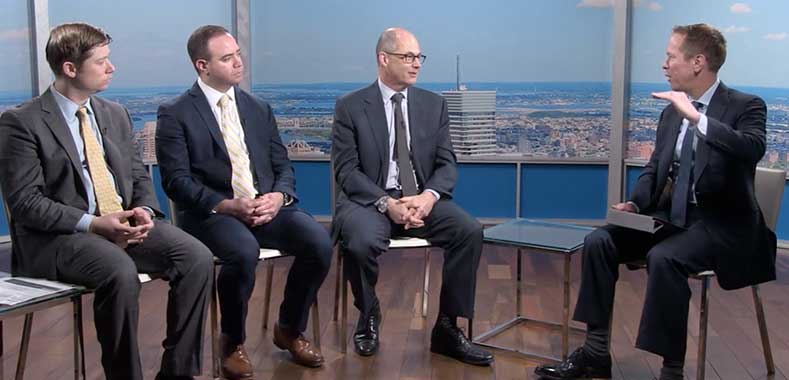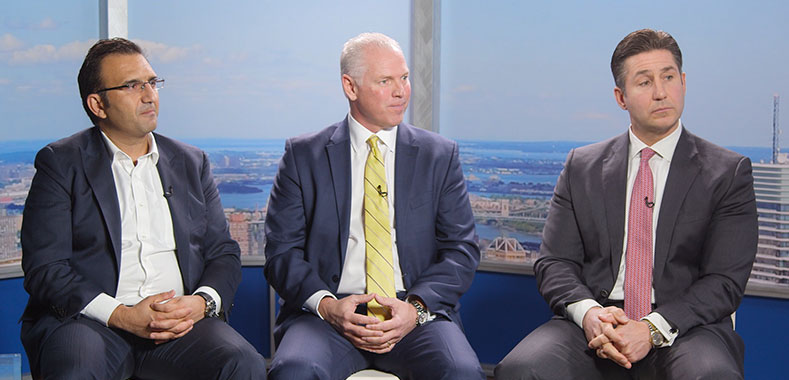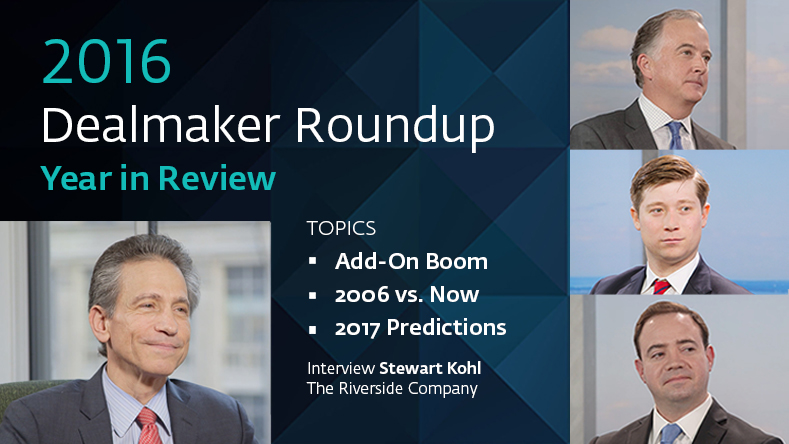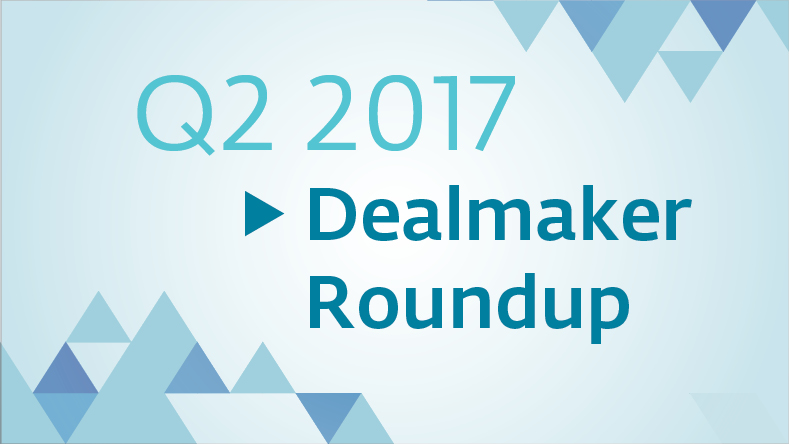Private Equity and the Software Industry: What’s Behind the Surge in Deals?
What smart investors need to know about the booming private equity market for software.
This 45-minute webinar video will teach you:
-
What’s driving interest in software companies
-
The most attractive sectors for private equity investment
-
The exit environment
-
And key drivers of success
Transcript Download Transcript
Private Equity and the Software Industry: What’s Behind the Surge in Deals?
Matt Malone, Privcap: Good afternoon, everyone. This is Matt Malone. I run the content and strategy operation here at Privcap. I’d like to welcome you all to our private equity and software industry webinar today. This is an interactive discussion (or we hope it is), so I invite you to all submit your questions in the Q&A panel at any time throughout the conversation. We’ll be doing an explicit Q&A session at the very end.
It is clearly a hot environment for private equity software deals, as you can see by the chart I’m pushing up here now. And I’m very pleased to have our three guests here today to discuss it. We have Arvindh Kumar from Thoma Bravo on the line. We also have Rob McIntosh from Autodesk and David Van Wert from RSM. I’m going to give them all a minute to give a brief introduction, and then we’ll get into our discussion. Arvindh, if you could, say hello to the audience and tell them a bit about Thoma Bravo and your role there.
Arvindh Kumar, Thoma Bravo: Sure. Hi, everyone. This is Arvindh Kumar with Thoma Bravo. I’m a principal at the firm. I help lead our application software efforts, including verticals such as healthcare IT, energy IT, real estate, autos, etc. As some of you may know, Thoma Bravo is one of the largest technology-focused private equity firms. We’ve been in business for 35 years. We helped pioneer the concepts of industry consolidation and buy and build investing for private equity. Today, we’re solely focused on technology and we have about $17 billion of assets under management.
We’ve done 140 acquisitions in technology, representing over $35 billion in aggregate enterprise value. We’re operating out of Fund 12 currently, which is about an $8-billion fund. And we have a $1-billion fund called The Discover Fund, focused on mid-market technology companies. So, we’re one of the most active technology private equity investors out there.
Malone: Thank you, Arvindh. Rob, if you wouldn’t mind introducing yourself.
Rob McIntosh, Autodesk: Sure. Hi, everyone. Rob McIntosh. I lead corporate development here at Autodesk, which means I’m in charge of all of our acquisitions, investments, strategic alliances and integration work. We also manage two different venture funds: one focused on 3D printing and another focused on the future of making things or our third-party platform that we’ve having others adopt as part of an ecosystem.
For those of you who don’t know Autodesk, we’re a public company and we’ve been around for almost 34 years. We have around $2.5 billion in revenue, $17.5 billion market cap, and we’re a leader in design software for architecture engineering, construction, manufacturing, media and entertainment and some other verticals. The way I explain it is that pretty much anything you see physically—be it a road, a car, an iPhone or a piece of furniture—or even digitally—be it a video game or a special effect in a movie—there’s a very high probability that Autodesk software was involved in designing, simulating or even making some of the different components of those things.
We’re an active acquirer. We’ve probably acquired around 100 companies in the last eight years or so. And there’s a fair amount of consolidation in our space that’s fueling that, as well as just our own transformation in this business.
Malone: Great. Thanks, Rob. David, please say hello to the audience.
David Van Wert, RSM: Thanks, Matt. Hey, everyone, this is David Van Wert. I’m a partner at RSM. For those of you who don’t know RSM, it’s the fifth largest accounting firm and the top middle-market accounting firm in the country. I lead our M&A due-diligence practice nationally for the technology industry and, within technology, I think we’ve worked on 300 buy-side and sell-side transactions over recent years. I’m happy to be here with Arvindh and Rob today and to provide my perspective.
Malone: Excellent. Let’s get into our first topic. Just give an overview of the market as you all see it. As you can see from the slide I’m putting up here, certainly in the buyout space for private equity, there has been an ever-increasing momentum in terms of the number of deals being done. So, Arvindh, starting with you, can you give a little perspective on what is driving this deal volume today?
Kumar: Sure, yes. Within technology, it’s a high-valuation environment. Sellers—prospective sellers—are inclined to sell. It’s very low interest rates, a ton of capital out there and cheap debt capital. Software, as an asset class and technology more broadly, has really grown in the face of lots of cyclical end markets such as energy and retail. Technology businesses such as digitization and automation have become more and more important globally and software has played an essential role in that transformation. So, irrespective of end-market cyclicality, technology companies have generally grown, which is attractive to prospective buyers.
Old-economy companies that want to become new-economy companies and small startup technology companies are getting a lot of venture capital dollars to keep growing. So, we’re seeing lots of deal activity given the combination of strong macro trends and very cheap capital out there.
Malone: Rob, what are you seeing from your perspective? In terms of driving deal activity, what’s drawing buyers and sellers in today’s market?
McIntosh: Sure. I agree 100%. Cheap debt is certainly fueling this. There’s excess cash domestically and in foreign markets. Frankly, we’ve seen a pretty big overhand of private equity capital. It seems like there’s recycling of assets that they spin from one PE firm to the next. I’m not sure if those are necessarily great assets or it’s just capital deployment that’s taking place.
One thing I’d say is that maybe just a hotter sector—do you want me to talk about that or just talk about the drivers at this point?
Matt: Sure, you can certainly talk about a sector if that’s appropriate.
McIntosh: Sure. I think one of the factors, particularly within some of the enterprise software markets, is just trying to change business models. There was a reference that people are trying to drive to more contemporary business models or to more contemporary markets or platforms. Certainly, there are a lot of startups that are active in developing great new cloud solutions. But, in older businesses like Autodesk and others, we’re seeing a big drive toward trying to drive both a business-model transition (i.e., moving from perpetual software to term-based software) and a transition from box software products or electronically delivered products to pure cloud-based products.
So, at least within our sector, we’ve seen a tremendous amount of consolidation as older businesses are trying to cross that chasm and either trying to move the business model or trying to contemporaneously move to a more cloud-connected model, which requires new talent, new back-end systems, new delivery methods and maybe even new sales channels as well. Certainly, as I’ve connected with my peers in older software businesses, that’s been a huge driver for their M&A activity.
Malone: Thanks, Rob. David, obviously, you talk to a number of clients active in this space. What are you seeing?
Van Wert: Yeah. Echoing what Arvindh and Rob said, I think the ease of obtaining debt and noting that that’s predicated on predictable recurring revenue, that’s obviously a large driver. Arvindh mentioned that technology is now touching pretty much all industries and, seeing that advancement, I think that’s driving leading to M&A opportunities and in line with the constant change and disruption that you see resulting from new technologies.
That leads to new opportunities. Then, as just the nature of the technology industry—rapid innovation refills the M&A pipeline. So there’s never a true shortage of good companies out there compared to some other industries where you might see, after a surge in M&A, there’s kind of a lull because a lot of the best businesses have already been bought.
Malone: Great. I want to move into a little drill-down into specific sectors that are seeing activity given your relative experience and expertise. I do want to remind everyone watching and tuning in here to submit questions via the Q&A submission tool. Let’s move from a sector perspective. Arvindh, one that you’re finding particularly attractive or active these days is in the healthcare software space. Can you talk about the opportunity there and who some of the players are?
Kumar: Sure. First of all, Thoma Bravo has invested—we have seven healthcare IT companies, so we’ve been one of the most active investors in healthcare technology. Some themes we’ve seen are regulatory related, which is the Affordable Care Act, known as Obamacare. Some of it is the HITECH Act, which was during the recession and had nothing to do with Obamacare. Some of it is just that hospitals are making less money and need to improve their bottom line and use technology as a way to do that. And, on some end, there are dynamics in life sciences, on the payer side, and then, just more across healthcare, where we’re seeing themes.
But I’d say I’d manifest that into four key themes where revenue-cycle management in alternate payment models, data analytics and then the post-acute space, where we’ve seen a lot of activity. On the revenue-cycle management side—it’s an overused term, but in how we apply it, there’s an increased need for productivity and accuracy from customers and so that hospitals and providers can get paid faster and have less denials. That’s a way for them, as they’re having to see more and more patients—they’re doing a lot of services, but to make sure they’re getting paid for that in an accurate way and fast enough.
That gets into the second point, which is alternate payment models. There’s been a shift to not just move away from fee-for-service and into more getting reimbursed based on value. So, if you have good outcomes as a provider, you can get paid more. If you have bad outcomes and people keep coming back or stay in very expensive settings, you get paid less by insurance companies and by the government. There’s a reliance, increasingly, on quality of care and there are a lot of technology companies that help assist in that transition.
The third [point] is data analytics, which is companies that help providers, payers, life sciences, you name it, with processing lots of healthcare data. One issue is that there are lots of systems that don’t talk to each other. There’s not just one closed system, but rather a lot that interoperate, so there’s lots of lost-in-translation data. That’s important to actually first gather data. Second, understand what it’s saying. Third, be actionable—do something about it on retrospective and then prospectively to avoid future issues. There are a bunch of companies that help in that third theme.
Then, fourth is the post-acute space. In-patient hospitals are getting hit pretty hard in terms of their cost base. And they’re trying to shift to lower cost settings post-acute, so they’re expanding care across the continuum into home health and to build nursing facilities, long-term care facilities. There’s an aging population with chronic conditions that need to be cared for in an increasing volume, given the baby boomer phenomenon. Post-acute settings are growing in importance, so having healthcare technology systems that can help address that has become an increasing focus for healthcare investors. So, those are the four themes we’ve really focused on. There are certainly others, but I hope that helps address the question.
Malone: Great, thank you. I think we’ll come back to some of the outlook questions later in the webinar. David, one thing you’ve talked about is the growing interest in cybersecurity. Can you talk about the complexion of that opportunity? We all understand that cybersecurity is becoming an increasing significant corporate risk, but what are you seeing in that space in particular?
Van Wert: Sure. Yeah, it’s obvious to everyone that cybersecurity is in the headlines on a daily basis, not be it Russian hacking or hacking of the DNC. All of that creates a lot of hype and brings new entrants into the market. I think we’re seeing needs not only for B2B cybersecurity assistance, but also for individual people and consumers. They want to make sure their data and information is safe as well.
I’ve read recently that—I think it was one in five companies has been hacked or had some sort of breach. I don’t know if that data point was known breaches or estimates of companies that have had breaches. Regardless, I think the number is high and will continue to increase. One interesting trend we’ve been seeing is that cybersecurity companies are also becoming targets just because of the confidentially of the information they have access to. That can be extremely damaging to the reputation of the business, but it can also crater a business whose core competency is cybersecurity.
I’d liken it to the front page of The Wall Street Journal saying “David Van Wert doesn’t know how to balance his checkbook.” That would be extremely damaging to my reputation as an accountant. Just given the threat to some of these cybersecurity businesses, that leads to additional risk to corporate acquirers or private equity acquirers who are looking to invest in these types of businesses. You don’t want to take on a time bomb or a landmine.
From an M&A perspective, I think there has been a lot of froth in the market for security. There’s been significant activity and high multiples. And, given all the new entrants, I would expect that there will continue to be very active M&A activity in the cybersecurity subsector. But I think we will see the best businesses being acquired and a lot of the pretenders who have gotten in just jumping on the bandwagon will be falling off.
Malone: Thanks. Arvindh, a quick follow-up question for you as it relates to healthcare: is that something you’re seeing, particular activity, when it comes to cybersecurity and privacy issues around healthcare? Has Thoma made any of those types of investments?
Kumar: Yes. We took private a company called Imprivata, which is squarely in the overlap of both—a single sign-on, security software company that sells to hospitals and providers. They’re a good example of that phenomenon that we’re focused on. HIPAA compliance and avoiding breaches of very confidential and patient information is really important in healthcare specifically, almost more than any other vertical. Imprivata is a company that we’ve backed, too, with that macro trend. They’re the best player in that space. It’s certainly something we’re seeing.
Malone: Rob, perhaps we could now move on to something you alluded to earlier, which is this notion of the so-called “gold-line” software companies looking to new models and startups that are launching with those new models. Can you talk about that opportunity and the types of companies you’re seeing come across your desk?
McIntosh: Sure. The first question is why? Why are people going to this effort? Anybody who follows the Street and follows the valuations of various companies can see that companies that successively are on a term-based model are typically more highly rewarded by the Street. It’s a good model for shareholders in that it just is a more reliable, more estimatable business model.
But certainly you don’t make those types of transitions, at least in business models, solely for shareholders. It also ends up being the right model for your customers as well because you’re able to provide a more minimal upfront capital investment. They’re able to have more flexible access to their solutions based on need. Therefore, the business model makes a lot of sense both for shareholders as well as customers. But it’s the cloud transition that really enables both a company like Autodesk or others as well as customers to gain more value from their software.
Often, you see companies say, “We’re a cloud-enabled or a cloud-connected solution”, but really they’re not leveraging any of the value the cloud can bring. Aside from just providing more universal access to software, you see things like (in our instance) the ability to do rendering or infinite computing in the cloud. You have an enhanced TAM expansion that you can offer by virtue of basically expanding your product or creating an ecosystem around your product that people can then latch on to and basically create long-tail or adjunct solutions to your software.
We’ve seen a whole number of companies that are starting up and entering our space or others, frankly because the cost to create these companies is lower than it’s ever been before. And people can leverage platforms like ours or Salesforce or others to basically get to scale a lot faster than they could have otherwise if they were to build a traditional enterprise software company. That’s one whole major trend that we’re seeing—companies just transitioning the business model or creating more flexible models with better customer choice by virtue of having cloud-connected products. Then, obviously, with that comes all the contemporary themes or the big hot spaces that you see in machine learning, in IOT or in our space in additive manufacturing or in others.
Basically, they’re able to leverage existing cloud platforms to get to market faster and also innovate a lot faster, so you see the speed of innovation being very, very high. And you see venture money and private equity money following these sectors to splurge and spend to get to scale and get to market fast. Anyway, those are the two big, hot themes that we see continuously on a general basis.
Malone: Just for the audience’s benefit, when you’re drawing this distinction about the ecosystem idea where you’re allowing other people to integrate with your products, that’s a distinction. For instance, Adobe’s product, Creative Cloud, is one where you’re deploying the software in the old way, on your own PC, and it’s simply authenticating your license. You’re talking about something different from that, correct?
McIntosh: Yes. A true cloud-based or cloud-connected system. An example for us would be if you’re producing or creating the latest version of Avatar. In the past, you would have used a single server to render one frame of the Avatar movie and it would take you five hours to render one frame. Instead of using one server, you can use our cloud and basically do versed rendering, where you can do 5,000 frames in an hour, for instance. That’s one example of the leveraging of infinite community.
The other would be a similar situation where, let’s say, you’re designing a building and you want to see all the different energy-loss or energy-consumption patterns that would happen if you switched the location of the building by five inches or you turned a window to be slightly larger or smaller. It could be simulating those responses and basically intelligently redesigning your building in the background as you continue to work on it. That’s the value of the cloud, at least within our space. It’s not just about being able to pick up your iPad and log in and be able to see your data. It’s actually leveraging the power of the cloud to drive better value for you.
Malone: Got it, OK. Again, I want to just remind everyone to submit questions via the Q&A panel. Let’s move on to the deal dynamics question: what does the composition of buyers and sellers look like today? Then, perhaps some things that are keeping them apart. David, can you start us off talking a bit about what the deal environment looks like in terms of the players?
Van Wert: Yes. Just given that multiples are still very high based on historical averages, I think the market is still very attractive to sellers. One thing that is probably keeping buyers and sellers apart is frequently just the preparedness of the seller. They might say, “Yeah, we’re going to get a great multiple here and a great purchase price,” but they haven’t really done the blocking and tackling to prepare for a sale. So, while we’ve seen in the RSM microcosm, we’ve seen the technology industry lag other industries in adoption of sale-side diligence.
That’s something that has been increasing significantly in the last couple of years just to speed up the transaction—to increase the likelihood to close—and, more importantly, just help to have a third-party viewpoint to vet the issues on customer retention, revenue recognition, quality of earnings and those types of things.
In terms of who’s really calling the shots in a deal, I would say any transaction is a negotiation when it all comes down to it. It probably depends on what type of deal you’re talking about. For instance, a seller probably has much more negotiating power if it’s a non-exclusive auction transaction versus a proprietary deal versus maybe a minority investment where it truly is a partnership going forward and no one wants to draw blood from the other party during the transaction.
Malone: Arvindh, what are you seeing in terms of the particular deal environment today?
Kumar: I’d say it’s pretty bifurcated in terms of we’re seeing very high-quality private companies not traded in the public markets—very high-quality private companies transacting, given the high multiple environment. They’re getting pretty large enterprise on these multiples, for example, CAMP Systems would be one. We just sold Deltek—we announced our sale of Deltek to Roper—last week, which is one of our best companies. We’re seeing top-quartile, top-decile quality businesses sell for pretty high multiples.
On the other hand, because there’s a scarcity of assets out there, there are not that many—when I say “good companies,” it means a lot of recurring revenue, very high retention rates, stable end markets, pricing power, high EBITA margins, high growth margins and those types of characteristics. There are not that many of them, especially in the size range we transact in, so there’s a supply-demand imbalance. On the other hand, on the public side, there have been a bunch of transactions where companies came out with very hot IPOs, but were not mature, not super well-run, and they keep missing quarters of earnings. So there’s been a lot of growth in the activist investor community and there have been a lot of deal companies put into processes because of activist investors in the public markets. So, we’ve seen a huge amount of growth in take-privates put into play by activists because of just poor guidance and then missing numbers consistently.
Malone: Great. Thank you. Rob, you and I talked before the webinar about your perspective on deployment of capital and what’s driving volume, in your mind, relating to the amount of capital available—some of the overhang. Can you talk a bit about that?
McIntosh: Yes. I’m not in private equity, but traditionally we haven’t seen a lot of private equity players involved in our space. Maybe the attractiveness of the sector is increasing, but it used to be that when we came to bid on a deal, if a private equity player was involved, they typically couldn’t move that fast or they just had tertiary interest. Recently, we’ve seen a recycling of private equity deals, but we’ve also seen private equity players coming in and bidding much more than the strategics. Maybe my sample set is small, but I probably have five to 10 transactions in the last year where the sponsors were outbidding the strategics, in some cases, by a factor of two to one.
It’s a really curious trend for us, considering that eventually, theoretically, our strategics or public markets would be the end point. It does seem like there’s some amount of overhang here that’s driving activity. Typically, at least what we’ve seen in sponsor deals, Tier 1 sponsors are not selling their transactions at those high values to other Tier 1 sponsors. They seem to be going to the Tier 3s or Tier 4s, which leads me to believe there is some amount of capital overhang that’s trying to drive the activity here.
And values are high, right? Values are high. Untouchable assets that we thought would never be for sale suddenly are actually selling and by untouchable, I mean highly desirable. People have been banging on the doors for years. No one’s been able to get into the door, but they’re actually engaging in processes. Timelines are much, much faster than they’ve been in the past and we’ve seen a big influx of activity. It just seems like it’s really high.
Malone: Arvindh, I know Thoma Bravo does not overpay for deals, but as a sponsor, how do you avoid or protect yourself in a market like this with high valuations, a lot of competition—the phenomenon that Rob talks about with sponsors outbidding strategics? How do you make money in this environment?
Kumar: Yes, it’s really tough. It’s a good question. We’re seeing a lot more competition and we’re seeing some folks that Rob mentioned: Tier 3-type sponsors that haven’t been in software technology trying to get in and they’re just overpaying, which they know and we know. So, you find your win rates probably going down a bit, but that’s OK because in those deals, you’d be not making much of a return on if you did bid them. In the deals we are doing, we need to stay disciplined. And the deals we’re doing are where we only buy the right assets, where we can add value through operational improvements, where our pattern recognition from doing 140 technology deals can be differentiated versus anyone else.
These are ones where they usually have very high revenue quality, but are just not managing the business the right way, for a variety of reasons that we think we can help improve. Then, with that conviction, with higher growth and higher margins that would come our way, we usually try to focus on companies that also have a fragmented end market where we can do M&A to either extend product lines or buy competitors or go into new geographies. That adds more earnings that you can borrow more against and it’s a virtuous cycle, which software has great characteristics in that respect.
So, long answer to that question, but it’s one where we have to find the needle-in-the-haystack companies where we think, while a headline price may look high on a pro-forma basis, we think it is much more reasonable due to or through some of the pattern recognition we have where we can improve a business much more quickly, if that makes sense.
Malone: It does. I want to move on to Q&A in a minute here, but I wonder if each of you could give about one minute on your outlook for 2017? Some of this will probably also be touched on in Q&A. David, let’s start with you. What are you looking at for the coming year?
Van Wert: I think it’s tough to predict. If you asked me a few months ago if I thought the Dow would almost be pushing 20,000, I probably would have said no. But I would expect that, particularly in the technology industry, you will continue to see the large, blockbuster transactions and the larger, take-private deals once the frothiness in the public market dips a bit. Then, I think that, on the flip side, you’ll probably see a lot of add-on acquisitions as current holders try to bolster their portfolio companies and really fill the gaps in terms of technology or sectors or region.
It’s that middle space where it’s a bit more uncertain for your middle-market technology companies. But I would expect 2017 to be active.
Malone: Thanks. Rob, what are your thoughts?
McIntosh: It certainly seems like it’s going to continue to be active. It’s odd. At the end of last year, I recall going to a meeting with a bunch of [corporate development] people and we were all looking forward to the crystal ball for this year. Everyone said, “There’s no way we can match 2015.” It was just such a crazy year. We finally get to take a break and relax. And, as you can see by the numbers you put up at the beginning of the webinar, this year has been a record year in software M&A on both numbers of transactions as well as total deal consideration.
It’s been a pretty robust almost three years at this point, but I don’t see it necessarily slowing down, at least not in massive ways—maybe a bit here and there. I think there could be an influx of M&A activity if corporates are able to repatriate cash to the U.S. as well. I think that would fuel even greater M&A activities, particularly domestically.
Malone: Arvindh, is that perspective consistent with your view of 2017?
Kumar: I agree that the first half of 2016 saw more technology deals than the entire 2015 by a couple of percent. I see 2017 probably growing relative to 2016. I agree with Rob that the repatriation would be a boom for corporates. I’d say on the private equity side, the Fed is talking about rate hikes, which adversely impacts the cost of borrowing and the interest rate on the debt and maybe how much you can borrow. That would bring asset prices down, theoretically, in what private equity companies can pay. Maybe the imbalance Rob mentioned, where private equity is paying twice as much as corporates, will rebalance a little more.
Also, we’ll have to see what happens with the new administration, but there’s a bunch of uncertainty around that not necessarily priced into the markets right now. Usually, with more uncertainty comes higher interest rates and, again, the same end result in terms of the amount you can borrow. Those would be the caveats to why, maybe, either prices moderate and/or there’s some less private equity buying versus corporates. But I agree with the overall trend line.
Malone: Great, thanks. Let move now into some questions that our audience has submitted. I’ll push this to either of you to answer. Any thoughts on the deal environment or competitiveness within the lower middle markets—the $15 to $40-million EBITA range—relative to other parts of the market?
Kumar: I’m happy to take that. This is Arvindh Kumar. We have a Discover Fund that focuses on exactly that and they’ve been very active. They see probably at least 20 deals a week. There’s a lot activity. There’s more activity in that market relative to the size. And I think that’s an area where, from an investor’s standpoint, you can still have more value, better returns and better multiples where the supply-demand imbalance isn’t as out of whack.
So that’s how I would characterize that size—the $15 to $40-million EBITA businesses. We’re seeing a lot of activity. There’s probably a little less competition from our viewpoint on those size deals than larger deals. Those size companies, there’s a lot of them, so in terms of the consolidation of fragmented end markets, there’s that opportunity is pretty ripe.
Malone: Great. Rob or David, any thoughts?
McIntosh: I haven’t seen any difference, be it large or small. It just seems like, across all, as long as there’s growth and good general characteristics of the business, they’re still just as robust as any other asset.
Van Wert: Yes, this is David. I would say that the lower middle market—and I think Arvindh was alluding to this—sometimes the lower middle market provides a private equity group more opportunity to insert expertise and also provides that bridge between the growth VC investing than a majority transactioner or buyout. So, just because the companies are smaller and frequently tend to have, ironically, even more hair on them than a larger company would, I think it is a subsector or a cross-section of the M&A market that can be very attractive.
Malone: David, on to the next question. I believe you mentioned this earlier, but if not, whoever did can jump in. We have a question from someone asking about defining the blocking and tackling that can be done by a seller in preparing for a sale. What are the steps to make a business an attractive target for private equity?
Van Wert: I think step number one is to make sure your house is in order. Make sure you’ve got your reporting cleaned up and you’ve got your advisors lined up before you go out to market. I think a lot of the time, sellers may jump the gun and say, “Let’s start talking to people about selling. Oh, someone mentioned an investment banker. We should go hire one of those. Someone mentioned sell-side diligence. We should do that, too,” and really letting the tail wag the dog.
In terms of fundamentals, I think a private equity investor is going to be looking for recurring revenue, ability to increase prices, white space in the market, management team quality, the technology itself and how good that is and how scalable that is. Those are some of the factors that a buyer is going to definitely look into. Arvindh probably has some additional perspective on that as well.
Malone: Arvindh?
Kumar: Yes. I think you hit it on the head, David. I don’t have too much more to add to that since we work with firms like David’s a lot, like McGladrey a lot. I think that’s exactly what we’re hired to do.
Malone: We have a specific question relating to the industrial technology space and how that’s being viewed in automotive or other similar manufacturing operations. Rob, some thoughts on that?
McIntosh: Sure. If I were to extrapolate, or at least the way I’d try to interpret that question is, in particular in industrial applications, we think there’s a massive opportunity in terms of how people are redefining the factory. We call it the factory of the future. You see this convergence of additive manufacturing—i.e., 3D printing, plus automated factory lines, plus connected devices so you can do machine-level monitoring—and you have the whole IOT layer.
You have all these different things that are coming at it that basically enable you to have more efficient factories, better usage of materials and more capital-efficient general designs and manufacturer processes that even enable you to potentially have lower headcount or much lower shipping costs or otherwise because you can actually set up factories or little micro factories in either specific countries of service or even on site in certain areas.
So it’s a hot sector right now. You see GE investing a lot in this space, you see Siemens coming after it, we’re coming after it and our competitors are coming after it. But mainly as it relates to the new stuff in terms of how you’re re-architecting or re-invigorating the space, less on the old-school industrial technology or industrial software stacks that are heavy ERP or EE or require big implementation times. These are lightweight, easy to install, easy to get going and have higher ROI applications.
Malone: Excellent. Thanks, Rob. Unfortunately, we are out of time. I’d like to thank Arvindh Kumar from Thoma Bravo, Rob McIntosh from Autodesk and David Van Wert from RSM for sharing their insights with us and for all of you for tuning in. Please do visit us at privcapdemo.com, where we have this sort of content on a regular basis. There will also be a replay of the webinar available at this address and, in a day or two, on privcapdemo.com for those of you who might have joined in the middle. Until our next webinar, I’d like to say thanks to all of you and happy holidays.







